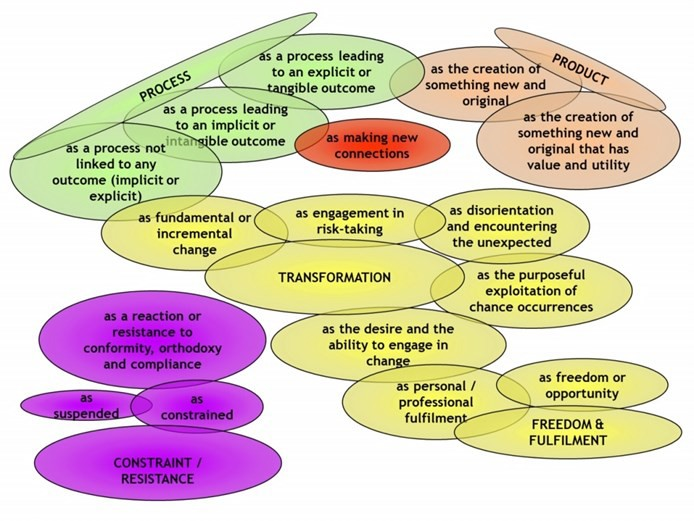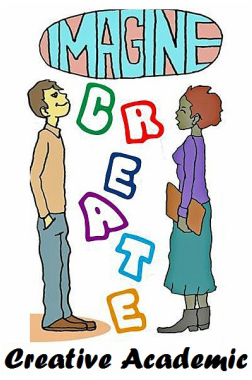I always started with the same question: Could you tell me about an occasion that was a creative experience for you in terms of learning and teaching higher education?
All too often that question would be greeted by silence, and what I came to call called the ‘rabbit in the head- light’ look: as if why on earth would I think that there might be a connection between creativity and teaching? But I’d learned, from my training and work in drama, not to be afraid of silence and to avoid the temptation to ‘jump in’ in order to avoid embarrassment. As a drama therapist once told me: “silence IS golden: it usually means they’re thinking”; and sure enough, after a short while, a story would emerge, and I would gently probe the whats, hows and whys of that particular experience.
The last interview of the day was with a vastly experienced educational developer, with a PhD in linguistics, who had taught in China. After the usual hesitant start, he began to tell me how he had developed a successful student-centred, experiential and problem-based learning experience which was the antithesis of the teacher- centred, conformist, ‘micro-teaching’ that was the normal and expected practice. It was he who described the experience with the Paul Klee ‘taking a line for a walk’ quote above.
Thinking back to those interviews, a number of ‘moments’ stand out:
The eminent, soon-to-retire historian bemoaning the conformity and lack of risk-taking in his younger colleagues, and finally – as his last ‘hurrah’ – running a ‘visual history’ course on 18th century England as seen through a number of key objects that he had always wanted to run but never had the nerve… until now when he was leaving. (This was way before Neil McGregor’s renowned BBC series on the objects of the British Museum).
There was the young, early career lecturer, genuinely committed to teaching, tears rolling down her face as she recounted the frustrations of having her creative ideas about teaching rudely quashed by her senior male colleagues: “I feel restricted, I feel frightened….the constant ‘don’t bother about the teaching, just focus on your research’….it makes me so angry, but I don’t dare say anything”.
And there was the language lecturer whose creative ‘Damascene’ moment occurred serendipitously as a result of being very late for a class she was meant to be teaching in parallel with other identical classes. When she finally turned up at the end of the session she found that the group, who normally “sat like puddings” while she presented the set material in the set textbooks, were still there and that “the atmosphere in the room was buzzing…they were talking to each other, they had a problem to solve. So we spent the last couple of minutes talking about how we were going to keep that going now”.
There were many such moments in all the interviews, and after personally transcribing all the interviews (extraordinarily tiring, but so valuable in being able to get ‘inside the source material’), I began to search for patterns of thoughts and behaviour. Slowly but surely, after a long and rigorous iterative process, the many and varied experiences of creativity in higher education began to coalesce around five main conceptual categories. I attempted to capture them in the following map:
2.Creativity can be a PROCESS-focused experience; that may lead to an explicit or tangible outcome…or may not;
3. Creativity can be a PRODUCT-focused experience where the whole point is to produce something;
4. Creativity can be a TRANSFORMATION-focused experience where the experience frequently transforms those involved in it;
5. Creativity can be a FUFILMENT-focused experience where there is a strong element of personal fulfilment derived from the process/production of a creative work.
As well as the development and identification of these five categories (later to be reduced to three – but that’s another story), a number of significant outcomes and observations sprang from the research.
It was clear that university teachers experienced creativity in learning and teaching in complex and rich ways, and certainly the ones I interviewed – once they got going - exhibited great enthusiasm for, and an interest in, creativity.
I was struck, particularly, in response to my exploring the reasons why an individual pursued a particular creative course, by the number of times someone said ‘I stumbled across something’ or something similar. The example of the very late lecturer (above) is a typical example. The frequency and consistency with which the opportunity to exploit the consequences of
‘stumbling upon something’ played a critical part in the various self-narratives of creativity in learning and teaching is clearly important, and it has obvious significance for those interested and engaged in learning and teaching. Firstly it is important to realise that there are several distinct but linked elements in this. One is the ‘stumbling’, and another is the ability or opportunity to exploit it. How- ever, as one of the university teachers interviewed said, people stumble across things all the time but rarely act: “So it's not just stumbling upon it, it's finding that the thing has a use”.
Then, beyond finding that whatever it is might have some use, one needs the confidence to be able to engage in an action that exploits – in the best sense of the word – that situation. The notion of confidence constitutes a significant and expanding thematic element through all the five categories. In many of the interviews - and it is one reason why actual face-to-face interviews are so important – as the individual began to explain and explore their own creativity (some said it was really the first time they’d ever really thought about it) - I both heard and observed the growing sense of confidence both vocally and physically: they became animated, they smiled and they laughed.
Confidence clearly plays a critical role in enabling university teaches to engage creatively in their pedagogic practice. However, in the research into conceptions of learning and teaching, little attention seems to be paid to the subject of confidence and other affective aspects of the teacher’s role and identity. A number of researchers comment on this apparent gap in the research literature, and explain it by saying that dealing with the emotional and attitudinal aspects of learning and teaching is rather antithetical to the prevailing analytic/ critical academic discourse.
During the course of those interviews there was a strong sense of people transformed. It is also clear that the centrality of creativity-as-transformation in relation to learning and teaching, and the importance of creativity in relation to personal and/or professional fulfilment, poses a series of challenges. The outcomes of the research suggest that there is much more to the experience of creativity in learning and teaching than simply ‘being creative’. Furthermore, the outcomes indicate that a focus on academics’ experience of creativity separated from their larger experience of being a teacher may encourage over simplification of the phenomenon of creativity, particularly in relation to their underlying intentions when engaged in creative activity.
The significance in these research outcomes is that academics need to be perceived and involved as agents in their own and their students’ creativity, rather than as objects of or, more pertinently, deliverers of a particular ‘creativity agenda’. The transformational power of creativity poses a clear challenge to organisational systems and institutional frameworks that rely, often necessarily, on compliance and constraint, and it also poses a challenge to approaches to learning, teaching and assessment that promote or pander to strategic or surface approaches to learning. For higher education institutions (and the government) creativity is seen as the means to an essentially more productive and profitable future. But for university teachers, creativity is essentially about the transformation of their students…and themselves.
Reference Kleiman, P. (2008) Towards transformation: conceptions of creativity in higher education. Innovations in Education and Teaching International 45 (3), 209-217 Also available at: http://www.creativeacademic.uk/resources.html



 RSS Feed
RSS Feed
